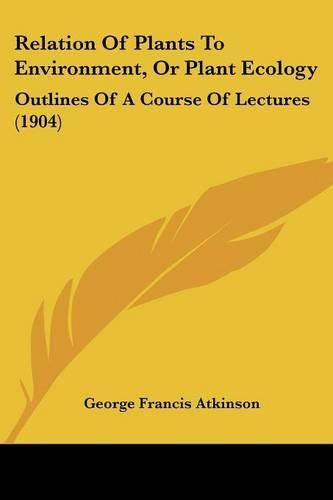Readings Newsletter
Become a Readings Member to make your shopping experience even easier.
Sign in or sign up for free!
You’re not far away from qualifying for FREE standard shipping within Australia
You’ve qualified for FREE standard shipping within Australia
The cart is loading…






Purchase of this book includes free trial access to www.million-books.com where you can read more than a million books for free. This is an OCR edition with typos. Excerpt from book: III. THE DIFFERENT TYPES OF STEMS. 1. Erect Ste1ns. Columnar or cylindrical type. 1. Simple or branched, Sunflower, mullein, Lombardy poplar, royal palm, tree ferns, some cedars, arbor vitae. 2. Advantages of the columnar habit. (1) More favorable light relation. (2) Maintain same habit when with others as when alone. (3) Less competition for existence. Cone type. 1. Main axis like a tall shaft. 2. Branching of two types? (1) False whorls Pines. Norway spruce. Douglas spruce. White pine. Growth movements ( Elongation of shoot. of young stems [Elongation of leaves. Rate of growth?year marks. (2) Spiral or distributed. Hemlock spruce, Larch. (3) Advantages of the cone type. 1. Less injury during high winds. 2. Admit light to a larger foliage area. 3. Less danger of injury from weight of snow. Oval type. Examples, oak, chestnut, apple. 1. Main axis usually disappears. 2. Exhibit character of habit best during winter. 3. Not so well adapted to higher altitudes and latitudes. 4. Deciduous habit enables them to withstand winds better. Deliquescent type. Example?elm. Main axis and branches fork by false dichotomy. Advantages of trees over less lofty vegetation. 1. Outgrow other kinds. 2. Shade the ground and drive out sun loving kinds. Prostrate type. 1. Strawberry. 2. Certain roses?Japanese rose (Rosa wichuriana). 3. Some raspberries. 4. Cucurbits?squash, melons, pumpkins, etc. 5. Economy in stem building. 6. Advantages? a. Protected from wind and cold. b. Propagate themselves by rooting here and there. Decumbent type. Stem erect at first, later bending in form of arch. Takes root where tip touches ground. Examples, Some raspberries. Some blackberries. Cl…
$9.00 standard shipping within Australia
FREE standard shipping within Australia for orders over $100.00
Express & International shipping calculated at checkout
Purchase of this book includes free trial access to www.million-books.com where you can read more than a million books for free. This is an OCR edition with typos. Excerpt from book: III. THE DIFFERENT TYPES OF STEMS. 1. Erect Ste1ns. Columnar or cylindrical type. 1. Simple or branched, Sunflower, mullein, Lombardy poplar, royal palm, tree ferns, some cedars, arbor vitae. 2. Advantages of the columnar habit. (1) More favorable light relation. (2) Maintain same habit when with others as when alone. (3) Less competition for existence. Cone type. 1. Main axis like a tall shaft. 2. Branching of two types? (1) False whorls Pines. Norway spruce. Douglas spruce. White pine. Growth movements ( Elongation of shoot. of young stems [Elongation of leaves. Rate of growth?year marks. (2) Spiral or distributed. Hemlock spruce, Larch. (3) Advantages of the cone type. 1. Less injury during high winds. 2. Admit light to a larger foliage area. 3. Less danger of injury from weight of snow. Oval type. Examples, oak, chestnut, apple. 1. Main axis usually disappears. 2. Exhibit character of habit best during winter. 3. Not so well adapted to higher altitudes and latitudes. 4. Deciduous habit enables them to withstand winds better. Deliquescent type. Example?elm. Main axis and branches fork by false dichotomy. Advantages of trees over less lofty vegetation. 1. Outgrow other kinds. 2. Shade the ground and drive out sun loving kinds. Prostrate type. 1. Strawberry. 2. Certain roses?Japanese rose (Rosa wichuriana). 3. Some raspberries. 4. Cucurbits?squash, melons, pumpkins, etc. 5. Economy in stem building. 6. Advantages? a. Protected from wind and cold. b. Propagate themselves by rooting here and there. Decumbent type. Stem erect at first, later bending in form of arch. Takes root where tip touches ground. Examples, Some raspberries. Some blackberries. Cl…